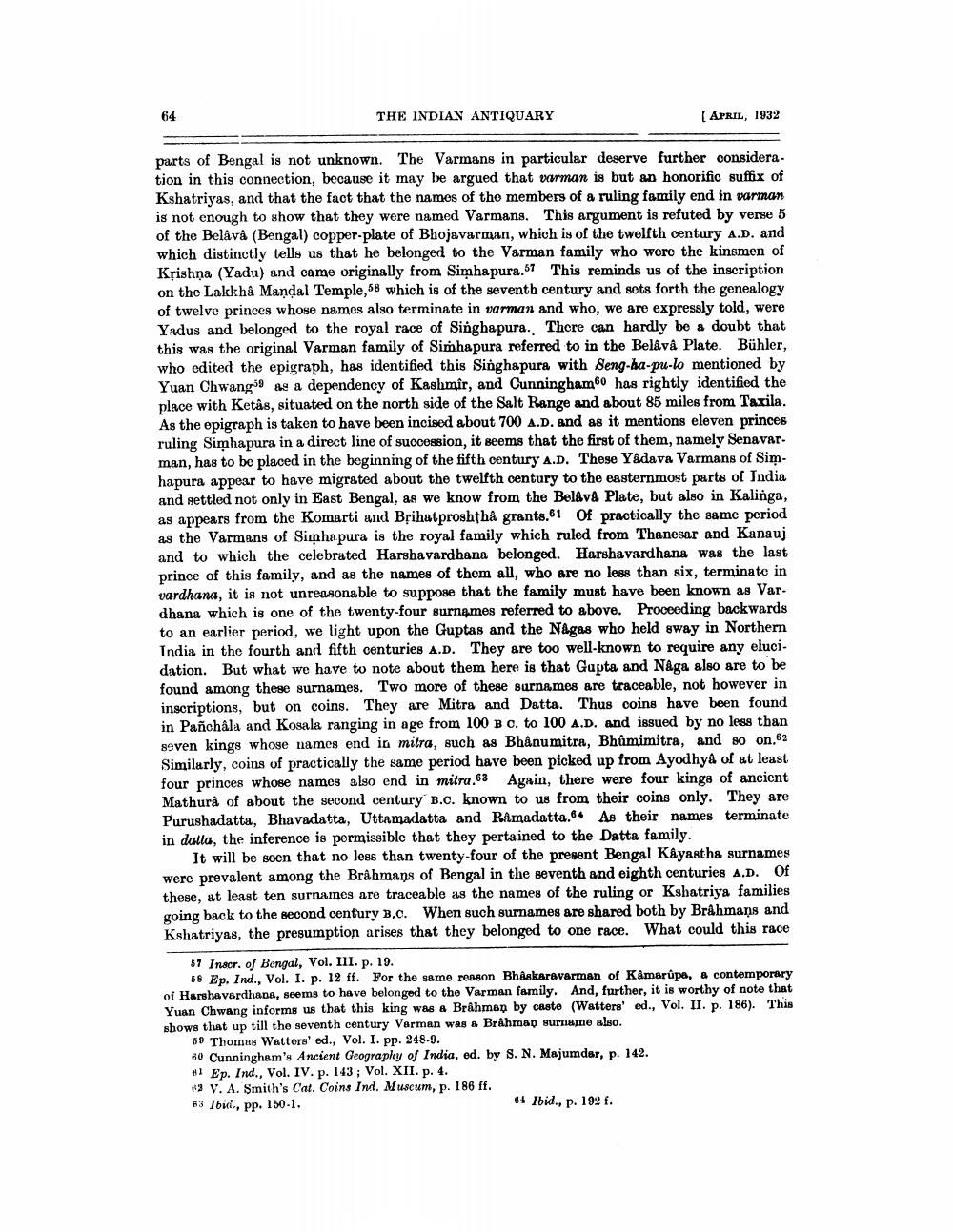________________
64
THE INDIAN ANTIQUARY
APRIL, 1932
parts of Bengal is not unknown. The Varmans in particular deserve further consideration in this connection, because it may be argued that varman is but an honorific suffix of Kshatriyas, and that the fact that the names of the members of a ruling family end in varman is not enough to show that they were named Varmans. This argument is refuted by verse 5 of the Belâvâ (Bengal) copper-plate of Bhojavarman, which is of the twelfth century A.D. and which distinctly tells us that he belonged to the Varman family who were the kinsmen of Krishna (Yadu) and came originally from Simhapura.67 This reminds us of the inscription on the Lakkha Mandal Temple, 58 which is of the seventh century and sots forth the genealogy of twelve princes whose names also terminate in varman and who, we are expressly told, were Yadus and belonged to the royal race of Singhapura. There can hardly be a doubt that this was the original Varman family of Simhapura referred to in the Belâvâ Plate. Bühler, who edited the epigraph, has identified this Singhapura with Seng-ha-pu-lo mentioned by Yuan Chwang39 as a dependency of Kashmir, and Cunningham has rightly identified the place with Ketâs, situated on the north side of the Salt Range and about 85 miles from Taxila. As the epigraph is taken to have been incised about 700 A.D. and as it mentions eleven princes ruling Simhapura in a direct line of succession, it seems that the first of them, namely Senavar. man, has to be placed in the beginning of the fifth century A.D. These Yadava Varmans of Simhapura appear to have migrated about the twelfth century to the easternmost parts of India and settled not only in East Bengal, as we know from the Beláva Plate, but also in Kalinga, as appears from the Komarti and Bșihutproshthå grants.61 Of practically the same period as the Varmans of Simhopura is the royal family which ruled from Thanesar and Kanauj and to which the celebrated Harshavardhana belonged. Harshavardhana was the last prince of this family, and as the names of them all, who are no less than six, terminate in vardhana, it is not unreasonable to suppose that the family must have been known as Var. dhana which is one of the twenty-four surnames referred to above. Proceeding backwards to an earlier period, we light upon the Guptas and the Nagas who held sway in Northern India in the fourth and fifth centuries A.D. They are too well-known to require any eluci. dation. But what we have to note about them here is that Gupta and Naga also are to be found among these surnames. Two more of these surnames are traceable, not however in inscriptions, but on coins. They are Mitra and Datta. Thus coins have been found in Pañchâla and Kosala ranging in age from 100 BC. to 100 A.D. and issued by no less than seven kings whose names end in mitra, such as Bhanumitra, Bhâmimitra, and so on.62 Similarly, coins of practically the same period have been picked up from Ayodhyâ of at least four princes whose names also end in mitra.63 Again, there were four kings of ancient Mathurâ of about the second century B.C. known to us from their coins only. They are Purushadatta, Bhavadatta, Uttamacatta and Ramadatta. As their names terminate in datta, the inference is permissible that they pertained to the Datta family.
It will be seen that no less than twenty-four of the present Bengal Kayastha surnames were prevalent among the Brâhmans of Bengal in the seventh and eighth centuries A.D. Of these, at least ten surnames are traceable as the names of the ruling or Kshatriya families going back to the second century B.C. When such surnames are shared both by Brahmans and Kshatriyas, the presumption arises that they belonged to one race. What could this race
57 Inscr. of Bengal, Vol. III. p. 19.
68 Ep. Ind., Vol. I. p. 12 ff. For the same reason Bhaskaravarman of Kamarupa, & contemporary of Harshavardhana, seems to have belonged to the Varman family. And, further, it is worthy of note that Yuan Chwang informs us that this king was a Brahman by caste (Watters' ed., Vol. II. p. 186). This shows that up till the seventh century Varman was a Brahmap surname also.
59 Thomas Wattors' ed., Vol. I. pp. 248.9. 60 Cunningham's Ancient Geography of India, ed. by S. N. Majumdar, p. 142. #1 Ep. Ind., Vol. IV. p. 143; Vol. XII. p. 4. 63 V. A. Smith's Cat. Coins Ind. Muscum, p. 186 ff. 63 Ibid., pp. 150-1.
64 Ibid., p. 192 f.




